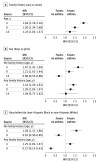US Childhood Asthma Incidence Rate Patterns From the ECHO Consortium to Identify High-risk Groups for Primary Prevention
- PMID: 33999100
- PMCID: PMC8129904
- DOI: 10.1001/jamapediatrics.2021.0667
US Childhood Asthma Incidence Rate Patterns From the ECHO Consortium to Identify High-risk Groups for Primary Prevention
Abstract
Importance: Asthma is the leading chronic illness in US children, but most descriptive epidemiological data are focused on prevalence.
Objective: To evaluate childhood asthma incidence rates across the nation by core demographic strata and parental history of asthma.
Design, setting, and participants: For this cohort study, a distributed meta-analysis was conducted within the Environmental Influences on Child Health Outcomes (ECHO) consortium for data collected from May 1, 1980, through March 31, 2018. Birth cohort data of children from 34 gestational weeks of age or older to 18 years of age from 31 cohorts in the ECHO consortium were included. Data were analyzed from June 14, 2018, to February 18, 2020.
Exposures: Caregiver report of physician-diagnosed asthma with age of diagnosis.
Main outcome and measures: Asthma incidence survival tables generated by each cohort were combined for each year of age using the Kaplan-Meier method. Age-specific incidence rates for each stratum and asthma incidence rate ratios by parental family history (FH), sex, and race/ethnicity were calculated.
Results: Of the 11 404 children (mean [SD] age, 10.0 [0.7] years; 5836 boys [51%]; 5909 White children [53%]) included in the primary analysis, 7326 children (64%) had no FH of asthma, 4078 (36%) had an FH of asthma, and 2494 (23%) were non-Hispanic Black children. Children with an FH had a nearly 2-fold higher incidence rate through the fourth year of life (incidence rate ratio [IRR], 1.94; 95% CI, 1.76-2.16) after which the rates converged with the non-FH group. Regardless of FH, asthma incidence rates among non-Hispanic Black children were markedly higher than those of non-Hispanic White children during the preschool years (IRR, 1.58; 95% CI, 1.31-1.86) with no FH at age 4 years and became lower than that of White children after age 9 to 10 years (IRR, 0.67; 95% CI, 0.50-0.89) with no FH. The rates for boys declined with age, whereas rates among girls were relatively steady across all ages, particularly among those without an FH of asthma.
Conclusions and relevance: Analysis of these diverse birth cohorts suggests that asthma FH, as well as race/ethnicity and sex, were all associated with childhood asthma incidence rates. Black children had much higher incidences rates but only during the preschool years, irrespective of FH. To prevent asthma among children with an FH of asthma or among Black infants, results suggest that interventions should be developed to target early life.
Conflict of interest statement
Figures




References
-
- Centers for Disease Control and Prevention. 2018 National health interview survey (NHIS) data. Accessed February 10, 2020. https://www.cdc.gov/asthma/nhis/2018/table4-1.htm
Publication types
MeSH terms
Grants and funding
- UH3 OD023288/OD/NIH HHS/United States
- U24 OD023382/OD/NIH HHS/United States
- UG3 OD035517/OD/NIH HHS/United States
- UH3 OD023271/OD/NIH HHS/United States
- UH3 OD023287/OD/NIH HHS/United States
- UM1 AI114271/AI/NIAID NIH HHS/United States
- UG3 OD023282/OD/NIH HHS/United States
- UH3 OD023268/OD/NIH HHS/United States
- P01 ES022832/ES/NIEHS NIH HHS/United States
- U2C OD023375/OD/NIH HHS/United States
- U19 AI095227/AI/NIAID NIH HHS/United States
- UH3 OD023253/OD/NIH HHS/United States
- UH3 OD023285/OD/NIH HHS/United States
- UH3 OD023275/OD/NIH HHS/United States
- P30 ES001247/ES/NIEHS NIH HHS/United States
- UH3 OD023282/OD/NIH HHS/United States
- UG3 OD023271/OD/NIH HHS/United States
LinkOut - more resources
Full Text Sources
Other Literature Sources
Medical
Molecular Biology Databases
Miscellaneous

